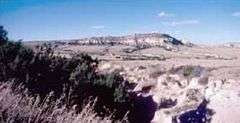Robidoux Pass
|
Robidoux Pass | |
|
Countryside in the pass | |
  | |
| Nearest city | Gering, Nebraska |
|---|---|
| Built | 1848 |
| NRHP Reference # | 66000450 |
| Significant dates | |
| Added to NRHP | October 15, 1966[1] |
| Designated NHL | January 20, 1961[2] |
Robidoux Pass, also known as Roubadeau Pass, Roubedeau Pass, Roubideau Pass, Roubidoux Passis and Roubadeau Pass Gap, is a gap passing through the Wildcat Hills near Scottsbluff, Nebraska about 9 miles (14 km) west of Gering, Nebraska. The gap was on the route of the historic Oregon or Emigrant Trail. It is at an elevation of 4,554 feet (1,388 m).[3] Used by thousands of emigrants to the west from 1843-1851, the pass is a National Historic Landmark.[2]
The area was named for members of the Robideau family, either Antoine or Joseph E. Robideau (also spelled Robidoux), who in the 1840s maintained a trading post east of the gap and later one at Scottsbluff. It contained blacksmith and grog shops, as well as other goods.[4] The pass lies a few miles west southwest of Scottsbluff, Nebraska in broken country south of the North Platte River and the Wildcat Hills.
Scotts Bluff blocked wagon travel along the south bank of the North Platte River, forcing early travelers to swing south and go through Robidoux Pass, a natural gateway in the great bluffs. In 1850, a shorter route was opened through Mitchell Pass, just south of the monument itself and much closer to the Platte River and eliminated the eight-mile swing south.[5]A local road, Robidoux Road, now passes through the gap. Robidoux Pass is located south of Scotts Bluff National Monument, 4.5 miles (7.2 km) south and 8 miles (13 km) west of Gering, Nebraska off Nebraska Highway 71 on Robidoux Road.[6][7]
The site was declared a National Historic Landmark in 1961.[2][8]
Its significance, as of designation in 1961, was described as:
Robidoux Pass was a significant landmark on the Oregon Trail. In 1848, an Indian trader named Robidoux established a trading post near this natural landmark on the old Oregon Trail. This route fell into disuse after the opening of Mitchell Pass in 1851 and the buildings disappeared.[2]
The Robidoux Trading Post has been reconstructed based on archeological evidence, as well as frequent accounts about it in traveler's diaries.
References
- ↑ National Park Service (2007-01-23). "National Register Information System". National Register of Historic Places. National Park Service.
- 1 2 3 4 "Robidoux Pass". National Historic Landmark summary listing. National Park Service. Retrieved 2008-05-06.
- ↑ Information page, U.S. Board of Geographical Names
- ↑ Page 147, Robidoux Chronicles: Ethnohistory of the French-American Fur Trade by Hugh M. Lewis, Trafford Publishing (July 6, 2006). trade paperback, 450 pages, ISBN 1412025702 ISBN 978-1412025706
- ↑ "Scotts Bluff National Monument/Mitchell Pass"
- ↑ Mapquest map
- ↑ Robidoux Pass" National Park Service website
- ↑ Note: A National Register of Historic Places Inventory-Nomination document should be available upon request from the National Park Service for this site, but it appears not to be available on-line from the NPS Focus search site.
External links
41°48′54″N 103°51′14″W / 41.8149688°N 103.8538362°W
